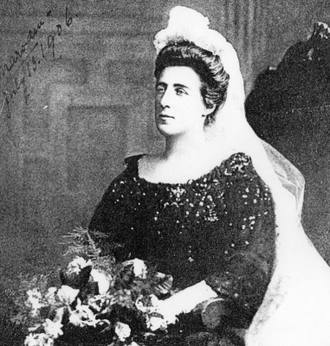St Francis Leprosy Guild celebrates founder's birthday

Kate Marsden in 1906
The extraordinary life of Kate Marsden (1859 - 1931)..
Throughout history and until an effective cure was found in the 1980s, people with leprosy were ostracised from their families, forcefully segregated from their communities, sent to leprosy communities, or abandoned.
St Francis Leprosy Guild was founded in 1895, by an inspired English woman, Kate Marsden, whose mission in life was to address the needs of people abandoned because of leprosy.
Kate was born in north London on 13 May 1859 to ordinary, middle class parents. As a young woman, she heard shocking news from Molokai missionary, Father Damien. His reports of people with leprosy being forcefully quarantined and living in poverty spurred her into action. She went and trained as a nurse at the Evangelical Hospital School of Nursing in Tottenham, at a time when nursing was a still a novel profession, especially for women.
In 1977, shortly after she qualified as a nurse, Kate was sent to care for soldiers fighting on the frontline in the Russo-Turkish war in Constantinople. It was during that time that she first encountered abandoned, outcast leprosy patients.
Her diary notes: "When I first turned my attention to the condition of people with leprosy my idea was to go and work for them in India; but to do that it was necessary that I should have help and experience."
Upon returning home she continued nursing and after the much-publicised death of Father Damien in 1889, her interest in helping leprosy-abandoned people was re-ignited.
She sought the patronage of Queen Victoria, who gives her a letter of introduction to the Imperial Russian court. There, she was befriended by many influential people including the Dowager Empress Maria Feodorovna and Princess Shakhovskoy both of whom were interested in establishing professional nursing in Russia and who were sympathetic to her cause.
While travelling through Siberia and Yakutia, she encountered more people suffering from the devastating effects of leprosy. Those experiences were to determine her entire future. For the rest of her life, she sought to engage others in the plight of people affected by leprosy.
She travelled several times to the United States on lecture tours, recounting her experience of meeting and caring for people with leprosy.
Shortly after her return from Russia she converted to Catholicism and became a Franciscan tertiary. Then in 1895 with the help of some influential Catholics, she established St Francis Leprosy Guild, whose patron was the Archbishop of Westminster, Cardinal Vaughan (1832-1903). Since then, every archbishop has become SFLG's patron including Cardinal Vincent Nichols today.
Initially, Kate was closely involved with the work of SFLG, but after allegations of misconduct, she decided to step down rather than risk jeopardising its good name and she left to live outside London.
Today it is difficult to unravel to what extent these accusations were based on jealousy, misunderstandings and most importantly, to anti-Catholic sentiment. Suffice to say that she died largely forgotten in 1931. However, the work of SFLG which she set up to combat leprosy has continued to this day.
For more information about St Francis Leprosy Guild, visit: www.stfrancisleprosy.org/
About St Francis Leprosy Guild 'SFLG'
St Francis Leprosy Guild is a UK based charity that works to end leprosy across the world. SFLG funds research projects, hospitals, and rehabilitation centres as well as active case finding projects to diagnose leprosy before it causes disability.
What is leprosy?
Leprosy (also known as Hansen's disease) is a chronic disease caused by the bacillus Mycobacterium leprae. It affects the skin, the upper respiratory tract and peripheral nerves in the hands and feet, and the eyes.
How is it transmitted?
It is thought that leprosy is transmitted via droplets from the nose.
How is leprosy diagnosed?
Leprosy is difficult to diagnose at its early stages, but it often presents as numb patches on the skin. Currently, the most reliable method to diagnose leprosy, is a slit-skin-smear test in the laboratory.
Leprosy may incubate for up to twenty years before presenting with any signs. If leprosy remains undiagnosed like this, the person affected may unwillingly transmit it throughout a community. However, within a short period of receiving multidrug therapy, a person affected by leprosy will no- longer be infectious. If leprosy is diagnosed in its early stages, it can be treated readily, and it will not cause disabilities. Preventing disabilities from developing means people with leprosy are less likely to suffer from the stigma and discrimination that can destroy their lives and livelihoods.
How infectious is leprosy?
95% of most populations have a natural immunity to leprosy. The remaining 5% become vulnerable, mainly through poor nutrition, poor living conditions, lack of hygiene and a weakened immune system. Leprosy is not hereditary.
Why are people with leprosy often so disfigured?
People with leprosy lose all feeling in the affected areas and as a result, there is diminished awareness of harm from trauma or heat. Without treatment, the lack of sensation can lead to permanent damage to skin, nerves, limbs, and eyes. It can also lead to the development of reoccurring, hard-to- treat ulcers.
Is there a cure?
Leprosy can be cured using multidrug therapy (MDT), available at no cost to patients from the World Health Organization. If MDT is taken in the early stages of the disease, permanent damage to nerves is completely avoided.
The latest WHO statistics revealed that in 2019 there were 202,185 new cases of leprosy diagnosed. Of concern and indicating ongoing transmission, the number of children newly detected was nearly 15,000.
However, these statistics do not account for those people who have leprosy with no symptoms or, who are not diagnosed and are unwittingly transmitting it to their communities. In addition, the statistics do not include those individuals who have been treated for leprosy, but whose disabilities, caused by leprosy need ongoing healthcare needs, or those who are subject to leprosy stigma and discrimination.
There are 23 WHO global priority countries for leprosy, where 95.9% of the global total of people detected with leprosy are found. The highest number of people newly detected with leprosy in 2019 live in India with 114,451, followed by Brazil with 27,863 and Indonesia with 17,439.
WHO Weekly epidemiological record, Global Leprosy Update 4 September 2020, 36, 2020, 95, 417-440 www.who.int/wer


















